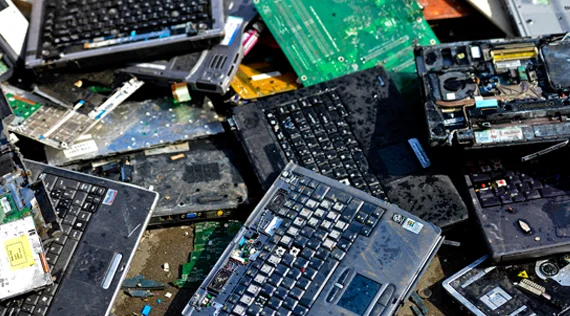Recycling electronics is crucial in tackling the growing e-waste crisis.
SEATTLE (Scrap Monster): From the moment it is manufactured to the moment it is discarded, electronic devices leave an environmental trail. The production is a particularly power-intensive process, requiring the extraction of rare Earth metals and complex production processes that generate significant emissions.
Once in use, electronics contribute even more emissions, especially with the skyrocketing demand for web-surfing, social media, streaming, and video conferencing. In fact, these digital activities can account for up to 40% of the per capita carbon budget necessary to limit global warming to 1.5. Not to mention artificial intelligence. Disposal is the final challenge, with less than a quarter of all e-waste currently being recycled. Improper e-waste management releases toxic chemicals and worsens pollution.
Understanding how a device’s life cycle impacts the environment lets individuals take steps to reduce their digital carbon footprint and contribute to a more sustainable future.
How to Measure the Environmental Impact of Technology
Three key metrics stand out in the carbon footprint of electronic devices: electricity usage, manufacturing emissions, and e-waste generation.
Many do not realize how small, everyday habits can add up. For example, a single year of incoming emails can generate 136 kilograms of carbon emissions — the same as driving 320 kilometers (198.8 miles) in an average car.
Streaming videos, web browsing and cloud storage contribute to energy consumption, too, especially in regions where power comes from fossil fuels. By tracking personal tech use — like monitoring screen time or managing storage — people can pinpoint areas for improvement. Likewise, deleting unnecessary emails, unplugging chargers or activating energy-saving settings can significantly reduce a digital carbon footprint and make tech use more sustainable.
The Role of Electronic Devices in Accelerating Climate Change
E-waste is becoming one of the fastest-growing environmental challenges, with millions of discarded devices piling up in landfills every year. These electronics release toxic chemicals like lead, mercury and cadmium, which seep into soil and water, harming ecosystems and human health. As consumers upgrade their gadgets more frequently, the volume of e-waste continues to climb.
On the digital front, data centers drive a surge in carbon emissions as cloud-based services expand. Powering and cooling these massive facilities requires enormous amounts of electricity, much of which still comes from fossil fuels. Streaming videos, storing files in the cloud and running digital communications all contribute to this growing demand.
By 2040, digital data storage could account for 14% of the world’s total emissions — the same amount the US emitted in 2021. Combined with the demand from everyday products like smart devices, the digital world’s reliance on fossil fuels accelerates climate change. Without a shift to cleaner sources and more sustainable tech habits, the environmental impact of the digital age will only intensify.
How Everyday Gadgets Add Up
Everyday tech accessories like chargers and earbuds come with hidden environmental costs that often go unnoticed. These seemingly small gadgets require power-intensive manufacturing processes and resource extraction, leaving a considerable carbon footprint. Adding to the problem is planned obsolescence — where products are deliberately designed to have shorter lifespans, which pushes consumers to replace devices more frequently.
This constant cycle of upgrades creates a surge in e-waste and further depletes valuable resources. As a result, human activities — including unchecked electronic consumption — have driven global temperatures to increase over the past 200 years. The significant increase has resulted in severe consequences for ecosystems and weather patterns.
On a global scale, the cumulative impact of electronic consumption is staggering. Billions of devices — from the smallest to larger electronics — collectively contribute to emissions through production, usage and disposal. While individual accessories may seem insignificant, the sheer number of these hardware worldwide amplifies their environmental toll. Combined with the constant demand for newer models, this unsustainable cycle accelerates the climate crisis.
Steps to Reduce Your Electronic Carbon Footprint
Reducing the carbon footprint of electronic devices doesn’t require drastic changes — small, intentional steps can make a big difference. Making smarter choices can minimize waste, conserve energy and help combat climate change.
Before Purchase
One of the simplest ways to lower electronics’ environmental impact is to buy refurbished or second-hand gear. Choosing pre-owned tech extends the life span of existing products and reduces the need for new manufacturing, which is a major source of carbon emissions and resource depletion.
For those who prefer buying new products, opting for efficient models is practical. Devices with certifications like Energy Star minimize electricity consumption and lower emissions over time. Prioritizing refurbished gadgets and alternative options can reduce digital footprints while saving money.
During Use
Optimizing consumption is a simple yet impactful way to reduce the environmental impact of electronic equipment. Many continue to draw power when turned off — a phenomenon known as “phantom energy” — which adds to waste and unnecessary emissions. Unplugging chargers and using smart power strips can help prevent this hidden drain.
Updating software and replacing worn-out batteries can also extend the lifespan of electronics, reducing the need for new ones. Individuals can use renewable sources like solar chargers to power smaller devices for a greater impact. These steps conserve power and create a more sustainable relationship with technology.
After Use
Recycling electronics is crucial in tackling the growing e-waste crisis. Between 2014 and 2020, greenhouse gas emissions from electronics and their associated e-waste increased by 53%. Certified e-waste recycling programs are essential in recovering valuable materials like metals and plastics while safely managing toxic chemicals that could otherwise harm the environment. Sensitive materials like hard drives can be shredded or degaussed with a magnet so that items can be recycled immediately without data leak risks.
Individuals can donate or resell devices that still work, giving them a second life and reducing the demand for new production. These actions can help cut emissions, conserve resources and minimize the harmful effects of discarded electronics on the planet.
Small Changes Lead to Big Environmental Impact
Recycling electronics responsibly and reducing electricity consumption may seem like small acts, but they can create a significant impact when millions of people do them. Sustainable habits and holding industries accountable can reduce emissions and protect the planet for future generations.
Courtesy: www.earth.org





 Member
Member